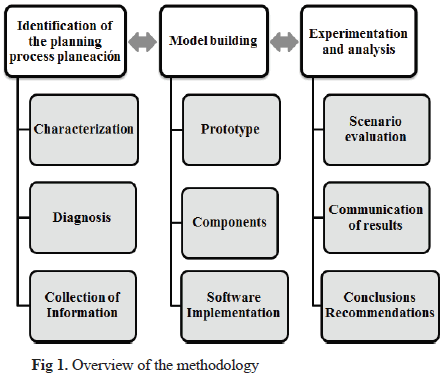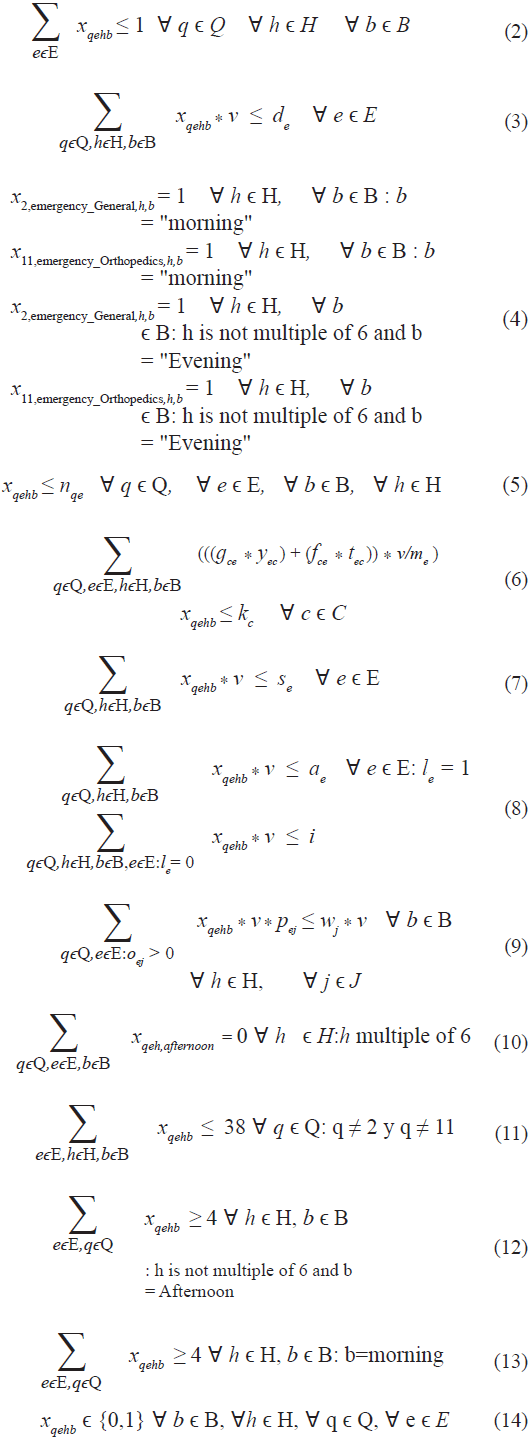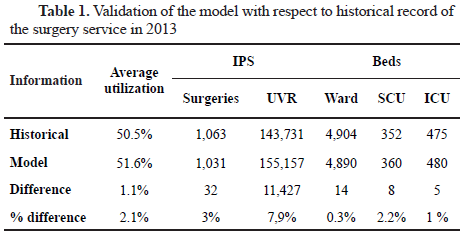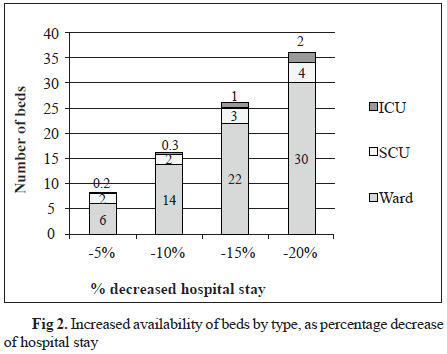Servicios Personalizados
Revista
Articulo
Indicadores
-
 Citado por SciELO
Citado por SciELO -
 Accesos
Accesos
Links relacionados
-
 Citado por Google
Citado por Google -
 Similares en
SciELO
Similares en
SciELO -
 Similares en Google
Similares en Google
Compartir
Revista Ingeniería Biomédica
versión impresa ISSN 1909-9762
Rev. ing. biomed. vol.9 no.18 Medellín jul./dic. 2015
ANALYZING THE CAPACITY OF THE IPS UNIVERSITARIA SURGERY SERVICE VIA INTEGER PROGRAMMING
ANÁLISIS DE LA CAPACIDAD DEL SERVICIO DE CIRUGÍA DE LA IPS UNIVERSITARIA VIA LA PROGRAMACIÓN INTEGER
ANÁLISE DA CAPACIDADE DE SERVIÇO DE CIRURGIA UNIVERSITÁRIA VIA A PROGRAMAÇÃO INTEGER
Edwin Alonso Álvarez Tobón1, Paula Andrea Velásquez Restrepo2, Juan G. Villegas1
1 Departamento de Ingeniería Industrial, Facultad de Ingeniería, Universidad de Antioquia. Medellín, Colombia.
Dirección para correspondencia: edwin.alvarez@antioquia.gov.co.
2 IPS Universitaria, Medellín, Colombia. Research Group: Innovación y Gestión de Cadenas de Abastecimiento - INCAS.
ABSTRACT
In this paper we propose a mathematical programming model to optimize the tactical planning of the surgery service of a complex Colombian Hospital by using efficiently its resources, seeking for greater financial incomes and analyzing its capacity. In the model, we consider the main resources involved before, during and after surgical procedures. The main results are: a) the post-operatory beds, especially in the intensive care unit (ICU) and at the surgical ward, are the limiting resource of the capacity of this service; b) There is an average underutilization of 48.4% in operating rooms and 33% in the available human resources (mainly surgeons and anesthesiologist); d) reducing the duration of the pre- and post-surgery stay is an option to increase the availability of beds. Key findings suggest the following improvement options: a) Closing or disabling some operating rooms, could reduce the costs and improve the utilization of the service without jeopardizing the fulfilment of its demand; b) working on the increase of the demand for outpatient surgeries could be a good option, since they do not require additional beds; c) combining the closure of operating rooms and the increase of demand for outpatient surgery is an interesting option.
KEYWORDS: Surgery; Tactical planning; Mathematical programming.
RESUMEN
En este trabajo se propone el modelo de programación matemática para optimizar la planificación táctica del servicio de cirugía de un complejo hospitalario de Colombia mediante el uso eficiente de sus recursos, en busca de mayores ingresos financieros y el análisis de su capacidad. En el modelo, se consideran los principales recursos involucrados antes, durante y después de los procedimientos quirúrgicos. Los principales resultados son los siguientes: a) las camas pos-operatorias, especialmente en la unidad de cuidados intensivos (UCI) y en la sala de cirugía, son el recurso limitante de la capacidad de este servicio; b) Existe una subutilización promedio de 48,4% en los quirófanos y el 33% en los recursos humanos disponibles (principalmente cirujanos y anestesiólogos); d) la reducción de la duración de la estancia antes y después de la cirugía es una opción para aumentar la disponibilidad de camas. Las principales conclusiones sugieren las siguientes opciones de mejora: a) Clausura o inhabilitación de algunos quirófanos, podría reducir los costos y mejorar la utilización de los servicios sin poner en peligro el cumplimiento de su demanda; b) trabajando en el aumento de la demanda de cirugías ambulatorias podría ser una buena opción, ya que no requieren camas adicionales; c) combinar el cierre de quirófanos y el aumento de la demanda de cirugía ambulatoria es una opción interesante.
PALABRAS CLAVE: Cirugía; planificación táctica; programación matemática.
RESUMO
Neste trabalho, é proposto o modelo de programação matemática para otimizar o planejamento tático do departamento de cirurgia de um complexo hospitalar na Colômbia através do uso eficiente dos seus recursos, em busca de rendimentos de juros e maior capacidade de análise. No modelo, são considerados os principais recursos envolvidos antes, durante e depois de procedimentos cirúrgicos. Os principais resultados são: a) as camas de pós-operatório, especialmente na unidade de terapia intensiva (UTI) e sala de cirurgia são a capacidade de recurso limitante deste serviço; b) Existe uma subutilização média de 48,4% em salas de operação e 33% em recursos humanos (principalmente cirurgiões e anestesiologistas); d) redução do tempo de permanência antes e após a cirurgia é uma opção para aumentar a disponibilidade de leitos. Os principais resultados sugerem as seguintes melhorias: a) Encerramento ou desativando algumas salas de cirurgia, poderia reduzir custos e melhorar a utilização dos serviços sem pôr em perigo o cumprimento de sua demanda; b) trabalhar para aumentar a demanda por cirurgia ambulatória pode ser uma boa opção, pois não exige camas adicionais; c) combinar o fechamento das salas de operação e a crescente demanda por cirurgia ambulatória é uma opção interessante.
PALAVRAS-CHAVE: Cirurgia; Planejamento tático; Programação matemática.
I. INTRODUCTION
Studies of Colombian hospitals, in different cities, indicate that the average utilization of the operating rooms is between 60% and 77% [1-6]. This underutilization condition is similar at the IPS Universitaria, (hereinafter, IPS-U) a high complexity Hospital located in Medellin (Colombia). Preliminary studies identified that the underutilization could be caused during the tactical planning of the surgery service. Mainly because the required amount of resources needed to meet the demand of the service and its capacity is unknown for the directive staff of it.
Therefore, in this work we propose a tool to support the planning and decision-making at the strategic and tactical level of the surgery service of IPS-U. The tool aims to find the capacity of the service using a mathematical programming model; an Operations Research technique that optimizes the allocation of surgical specialties to the available operating rooms at IPS-U during a given planning period.
II. METHODOLOGY
In a surgery service, the tactical planning for a given month determines the number and type of operating rooms available, the opening hours, and the surgery with priority in each operating rooms in each time slot. To support the tactical planning of the IPS-U surgery service we built an integer programming (IP) model, whose objective function maximizes the monetary income of the service. This value was measured in terms of UVRs (relative unit value or UVR - a standard measure of the income that IPS-U will receive for each surgery depending on its specialty and complexity).
This model includes the most important components of the process and considers the key resources used in the surgery service. We use this model to analyze the capacity of the service and also explore different scenarios following the methodology depicted in Fig 1.
The output of this model not only determines the tactical planning, but also calculates the consumption of key resources, the served demand and the monetary income. The description of this IP model follows.
A. Notation
Sets:
Q: Set of operating rooms. Q = {1, ..., 16}
E: Set of surgical specialties. Twenty three different specialties ranging from low complexity outpatient specialties like orthopedic and ophthalmic surgery, to very complex inpatient specialties like neurological and cardiothoracic surgery.
H: Set of days of the planning horizon. H ={1, ..., 22}
C: Types of hospital beds required for patients undergoing surgery. C = {ICU, SCU, Ward}
B: Set of surgical blocks programmed daily for surgery. B ={morning, afternoon}
J: Set of equipment used by the various specialties, e.g. microscope, surgical image intensifier, etc.
Parameters:
de :Expected demand, in hours, of specialty e ∈ E during the planning horizon.
v: Time in hours of each surgery block/slot.
re: Average income of a surgery in specialty e ∈ E.
neq: Binary parameter that indicates if operating room q ∈ Q is enabled for specialty e ∈ E (neq = 1), or not (neq = 0).
me: Average duration, in hours, of surgeries in specialty e ∈ E.
se: Number of hours of surgeon available for specialty e ∈ E.
le : Binary parameter le indicating if specialty e ∈ E requires specific training of the anesthesiologist (le = 1) or not (le = 0).
ae: Number of hours available of trained anesthesiologist for specialty e ∈ E.
i: Number of hours of general anesthesiologist available in the planning horizon (i.e., anesthesiologist that do not require specific training).
fec: Average pre-surgical stay, in days, for the specialty e ∈ E, for each type of bed c ∈ C.
gec: Average post-surgical stay, in days, for the specialty e ∈ E, for each type of bed c ∈ C.
tec: Percentage of pre-surgical patients of the specialty e ∈ E that requires the type of bed c ∈ C.
yec: Percentage of post-surgical patients of the specialty e ∈ E that requires the type of bed c ∈ C.
kc: Number of stay-days available for bed type c ∈ C.
oej: Binary parameter indicating if surgeries of specialty e ∈ E requires specific equipment j ∈ J (oej = 1) or not (oej = 0).
wj: Units of equipment of type j ∈ J available.
pej: Percentage of surgeries of specialty e ∈ E that require equipment of type j ∈ J.
uh: Minimum operating rooms assigned to the emergency service for each day h ∈ H of the planning horizon.
Decision variables:
xqehb: Binary variable indicating if operating room q ∈ Q is assigned to specialty e ∈ E in block b ∈ B of day h ∈ H (xqehb = 1) or not (xqehb = 0).
With the notation introduced previously, the integer program for the tactical planning of IPS-U surgery service can be formulated as follows:
B. Integer programming model
Subject to the following conditions
The objective function z (1), represents expected money income of the service during the planning horizon. Constraint (2) ensures that only one specialty is assigned to an operating room in a given day and block. Constraints (3) states that the total time assigned in the planning horizon for each specialty is lower than its demand. There are two operating rooms permanently assigned for emergencies (that are considered as two different specialties: general emergencies and orthopedic emergencies), constraints (4) express this condition. Besides, constraints (5), (6), (7), (8) and (9) represent the availability of the different resources, controlling the allocation of operating rooms, beds, surgeons, anesthesiologists and equipment, respectively. Specifically, constraint (5) also states that surgeries of a given specialty can only be assigned to operating rooms enabled for it.
Since the service is open only half-day on Saturdays, constraints (10) forbid the assignment of any specialty in the afternoon block for this day. Moreover, constrains (11) sets a limit on the number of blocks that can be assigned to any operating room (but 2 and 11) to prevent congestion (i.e. utilization close to 100%) and to leave some spare time to react to unforeseen events. On the contrary, constraints (12) and (13) guarantee a minimum daily workload for the service to avoid empty days in the planning horizon. Finally, constrains (14) define the domain of the decision variables.
Model (1)-(14) was implemented using the MoselTM modelling language and solved using XpressMPTM [8]. The resulting model consist of 25,344 variables, 1,469 constraints. Calculating the optimal solution only takes 1.4 seconds on a desktop PC running under Window 7 Professional with an AMD E-450 APU processor running at 1.65 GHz with 6.0 GB of RAM.
III. RESULTS
A. Validation of the model
To validate the model we compared its results against the historical records of the surgery service for 2013. We measure the differences between them and found that the tactical plan proposed by the model shows no significant difference in several key performance indicators (KPI): for the utilization of the operating rooms and beds, and the number of surgeries the differences were below 3%. Moreover, the model identified a possible increase in the financial income (UVRs) of 8%. Table 1 presents the details of this validation stage.
The base case scenario defined with the results of the initial model were analyzed. Initial results indicate that 30 hours demanded of Pneumology and Otolaryngology were not allocated because of lack of beds. Moreover, this base case scenario showed that the limiting resources that prevent the service to attend more demand are the available beds for surgical patients, mainly ICU and ward beds, not the availability of operating rooms that have a low average utilization of only 51.6%. This situation is not new in the Colombian Health System, according to [9], the average number of beds per hospital (129) is the lowest in the region.
With respect to surgeons and anesthesiologists, a monthly slack of 1,086 hours, were identified. This implies a 33.3% underutilization of these resources and also an important over cost incurred by the IPS-U.
Therefore, to identify opportunities for improvement, the results of the base case scenario were compared with other proposed scenarios that represent different capacity decisions. The analysis of these scenarios follow.
C. Exclusion of operating rooms
Keeping the availability of all other resources at the base level, we excluded from one to five operating rooms. This scenario shows that the number of surgeries, the monetary income and the use of beds and other key resources does not change. Whereas the average utilization of the operating rooms can be increased between 55% and 75%, with an average increase of 4.5% by each operating room excluded.
D. Use of operating rooms at full capacity
Due to the slack time at the operating rooms, we use the model to find the amount of additional resources needed to use operating rooms close to 85%. According to [10], this is an ideal level of utilization for this resource. To achieve this, we relaxed the constraints of the limiting resources (e.g., beds) and obtained the following results.
To achieve this goal, IPS-U should increase the current capacity by 55% (adding 89 beds) at the surgical ward, other 57% for the Special Care Unit-SCU (adding 8 beds) and by 69% at the ICU (adding 11 beds). All these beds exclusively dedicated to patients that require surgery.
Additionally, it would require 17.6% more hours of general anesthesiologist and 20.6% more hours of surgeons, in two thirds of the specialties. Consequently, the surgery department would be able to handle almost 120% more of its current demand, achieving an average utilization of 87%. In this scenario, the service performs 1,787 surgeries and obtains 268,186 UVR. This values represent an increase of roughly 73% over the base case scenario in both KPIs.
E. Increasing demand for outpatient surgery
We increased the demand for outpatient surgeries in six profitable specialties to analyze a scenario with largest number of outpatient surgeries. Under these conditions, the model suggest that IPS-U would have 525 more surgeries, increasing 18.1% the average utilization of the operating rooms and obtaining 53,602 more UVR. This represents a 51% increase in surgeries and 35% in utilization and UVRs.
F. Combined exclusion of operating rooms and increased outpatient demand
Motivated by previous results, we analyzed a scenario with fewer operating rooms (thirteen) and increased demand for outpatient surgery. This scenario offers 523 more surgeries and 53,717 more UVRs with respect to the base case scenario. Under these conditions the average utilization for the operating rooms reaches 85% and the income for the service could increases by 35%. These results qualify this scenario as the most striking and interesting to pursue.
G. Sensitivity Analysis pre- and post-surgical stay
A final analysis was performed to identify other options to solve the beds scarcity. In this scenario we reduced iteratively the length of the pre- and post-surgical stay. The results of this scenario indicate that, for every 5% of reduction of the stay (pre and post-surgical) the surgery service would count additionally during the entire planning horizon, with eight more ward beds, one SCE bed and half of an ICU bed (i.e. 11 days available for one bed). Each 5% reduction of the stay allow for 1,442 more UVRs, 18 more surgeries and an increase of 0.7% in the utilization of the operating rooms, with respect to the base case scenario. Fig. 2 illustrates these results. However, length of stay reductions are interesting only up to 10%, if an increase in demand is not possible.
IV. CONCLUSIONS
In this paper we present an integer programing model to support the tactical planning of the surgery service of a complex Colombian Hospital (IPS-U). The use of this model to analyze different scenarios indicates that the availability of beds at the ICU and the surgical ward restrict the provision of surgical service of IPS-U. To face this situation, the IPS-U would have two options: the first one is to add new beds to this service. Whereas, the second one is to try to decrease the length of stay of surgical patients.
There are important underutilization of key resources of this service such as operating rooms (48.4%) and surgeons and anesthesiologists (33.3%). Adjusting resources to achieve acceptable levels of utilization of operating rooms is a daunting task. Firstly, because it would require a great job of marketing to increase demand by over 100%, with respect to the base case scenario. Secondly, it would also require an increase in bed's availability over 50% and nearly by 20% in very specialized human resources (i.e., surgeons and anesthesiologist).
On the other hand, disabling or excluding some operating rooms can be attractive as it would reduce operating costs and improve the utilization of this resource. This will require the use of best practices at the operational level since the spare resources has been used regularly to support the absorption of unforeseen events and also has made easier the short-term operational planning.
An interesting mixed scenario is to exclude some operating rooms and work to increase demand for outpatient surgeries. This alternative would increase the utilization of the operating rooms to recommended levels, achieving higher incomes for the service and also a greater number of surgeries without the need for the allocation of additional beds.
ACKNOWLEDGMENTS
The authors would like to thank the IPS Universitaria staff and its director León Jairo Montaño Gómez M.D., for the assistance and support received to carrying out this work. Also, we would like to thank Fair Isaac Co. for providing the academic research license of Xpress-MP through their academic agreement program.
REFERENCES
[1]. Bejarano M. Evaluación cuantitativa de la eficiencia en las salas de cirugía. Revista Colombiana de Cirugía, 26, 273-284, 2011. [ Links ]
[2]. Castañeda C. Modelo de Asignación de Casos Electivos de Cirugía. Proyecto de pregrado. Ingenieria industrial. Universidad de Antioquia. Medellín, 2010. [ Links ]
[3]. Jiménez A., Amaya C., Velasco N. Estrategias de programación de salas de cirugía: Un caso de aplicación en un hospital de Bogotá. Los cuadernos de PYLO-Logística Hospitalaria. Universidad de los Andes. Bogotá. Colombia, 2008. [ Links ]
[4]. Leguizamón P., Paz A. Mejoramiento del proceso de programación de cirugías de una institución hospitalaria de la ciudad de Cali. Proyecto de pregrado. Ingeniería Industrial. Universidad ICESI. Santiago de Cali, 2011. [ Links ]
[5]. Marín N., Moreno P., Puerta E. Causas que generan aumento en los tiempos muertos en el Área de Cirugía General de la Clínica Universitaria Bolivariana. Tesis de especialización en administración de servicios de salud. Universidad de Antioquia. Medellín, 2009. [ Links ]
[6]. Patiño N., Moreno M., Toro E. Modelamiento matemático del problema de ocupación de quirófanos. Revista Colombiana de Tecnologías de Avanzada, 2(20) 43-48, 2012. [ Links ]
[7]. Velásquez P., Jaén S., Rodríguez A. Aproximación Metodológica para la Planificación y la Programación de las Salas de Cirugía: Una Solución a los Problemas de Optimización. Revista Gerencia y Políticas de Salud, 12(24), 249-266, 2013. [ Links ]
[8]. Xpress MP. Fair Isaac Corporation. En: http://www.fico.com/en/products/fico-xpress-optimization-suite/. [ Links ]
[9]. Periódico El Pulso. Carencias del sistema hospitalario colombiano. (Diciembre del 2007). En: http://www.periodicoelpulso.com/html/0712dic/general/general-12.htm. [ Links ]
[10]. Munte J. Rendimiento quirúrgico, ¿es posible medirlo? En: http://joaquimmunte.blogspot.com/2009/02/los-quirofanos-espanoles.html. [ Links ]


















